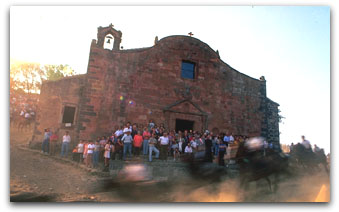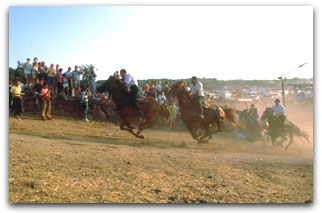According to the legend this man
saw two visions in which San Costantino appeared to him. In the second vision San Costantino
said "I will free you because I want you to have a church built for me. Take this bag of money,
go to Sedilo and have a church built on Isei mountain". The man from Scano di Monteferro
obeyed and had the church built. Later the Gothic church the man had built was enlarged and in
1789 it was renovated, in a more modern style, as the two inscriptions written in Spanish on the
church walls testify.
|
 |
|
What is strange is that the Spanish
had left Sardinia to Austrian domination 76 years before that date. Evidently the more than 400
years of Spanish domination had left their mark.
San Costantino is deeply loved by the Sardinan people. Every year, between the 5th and 7th of
July, tens of thousands of pilgrims go to Sedilo from all over Sardinia to honour
San Costantino.
|
Many of the pilgrims walk for days
and nights to reach the "sagra". The church walls are covered with prayers, objects and
testimonies for graces received. People do not come here to ask for miracles but to offer thanks
for favours received, to keep promises they made to San Costantino.
The "Ardia" is led by "sa prima pandela" (which means "the first flag" in the Sardinian
language). It is considered a great honour to be chosen as "sa prima pandela". Petitions to
become "sa prima pandela" are written in an old register kept in the parish church.
|
Usually a candidate has to wait for
many years to be chosen "sa prima pandela". The following are the criterion on which "sa prima
pandela" is chosen: chronological order of the petitions; the candidate having proven his
courage; demonstrated his horsemanship and substantiated his faith. "Sa prima pandela"
nominates the second and the third flag bearers which he chooses from among the most
capable horsemen.
|
|
 |
Then these three
horsemen nominate the escorts which have the very
important task of preventing the "enemy" horsemen from overtaking the "sa prima pandela",
who in a historical context represents the saint warrior San Costantino.
The preparations are long and
meticulous. A great importance is given to the choice and preparation of the horses which will
race between the shouting crowds that line the route from the village to the church. There are
hundreds of riflemen who will shoot blank cartridges loaded with black dust, almost as if to
prevent the galloping horses from running into the crowds which will pack every corner of this
bare slope that leads to the church.
|
|